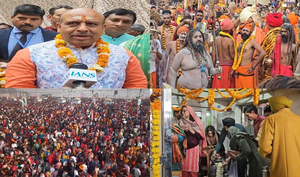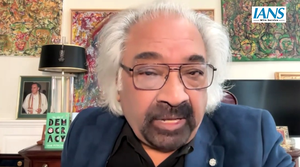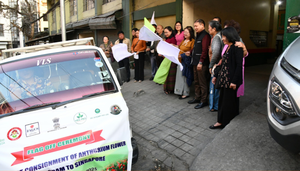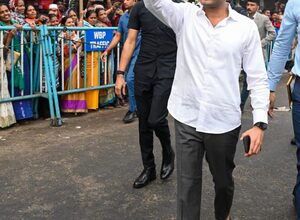Devotees flock to temples across India for grand Mahashivratri celebrations

New Delhi, Feb 26 (IANS) Mahashivratri, one of the most revered festivals in the Hindu calendar, is being celebrated across India with immense fervour and devotion. This sacred occasion, dedicated to Lord Shiva, is observed on the 14th day of the dark fortnight of Phalguna (falling between February and March) according to the Hindu lunar calendar.
It is often referred to as ‘The Great Night of Shiva,’ where millions of devotees gather to offer their prayers and seek blessings from the ‘Lord of Destruction’. This year, just like every other year, the entire nation is abuzz with spiritual energy, with temples filled with people, and the air vibrating with chants of ‘Har Har Mahadev.’
Mahashivratri is not merely a festival, it is a profound spiritual observance. For many, it is a time of personal reflection, fasting, meditation, and purification.
Devotees often refrain from food and water to demonstrate their devotion and surrender to the divine. The night is dedicated to Shiva, and people spend it in worship, prayer, and recitation of sacred texts.
It is believed that on this night, Lord Shiva performed the ‘Tandav’, the cosmic dance of creation, preservation, and destruction, making it a momentous occasion for spiritual renewal.
The celebrations, however, vary from region to region. While many observe a strict fast, others engage in a variety of rituals including the worship of the Shiva Lingam, the performance of ‘abhishekam (ritual bathing of the Shiva)’, and participation in grand processions.
Temples across the country dedicated to Lord Shiva are witnessing huge crowds of devotees, all eager to offer their prayers and receive the blessings of Bholenath (as Lord Shiva is affectionately called).
In Patna, Bihar, the Khajpura Shiv Temple has been the focal point of the celebrations. Devotees started queuing up since the early morning hours, their faces reflecting both devotion and excitement.
The air is thick with the fragrance of incense, and the sound of ‘Har Har Mahadev’ reverberates in every corner of the temple.
The temple is the venue for the main event, the ‘Shobha Yatra’, which will take place in the evening, with the Governor, Chief Minister, and various ministers in attendance to witness the procession and perform the ‘aarti’.
The enthusiasm is palpable, with people eagerly waiting to participate in this grand celebration. The ‘Shobha Yatra’, a procession of devotion, is a spectacular sight to behold, with beautifully decorated floats carrying deities, musicians, and dancers leading the way.
In Varanasi, the spiritual heart of India, the Kashi Vishwanath Temple attracted a multitude of devotees. A spectacular display of faith unfolded as Naga Sadhus, mystic ascetics who have renounced worldly attachments, performed their morning rituals in the temple, their long beards and matted hair adding an aura of mystery to the sacred atmosphere.
The devotion in their eyes spoke volumes about their connection to Lord Shiva. By 9:00 AM, the temple had witnessed over two lakh devotees, all partaking in the divine experience of ‘darshan’ and worship.
As the day goes on, the devotion here is palpable, as every devotee seeks a moment of connection with the supreme power.
In Uttar Pradesh, the Kumbh Snan (holy bath) has been a highlight of the Mahashivratri celebrations. With over 65 crore devotees having already bathed in the holy Sangam and visited the temples in the area, the event that attracted lakhs of devotees on Mahashivratri also, is a massive organisational feat.
The Uttar Pradesh Police played a crucial role in ensuring the smooth functioning of the events, ensuring safety and order amid the large crowds that milled on Mahashivratri.
In Prayagraj, the ancient Mankameshwar Temple has been resonating with the sounds of ‘Har Har Mahadev’ since the early morning hours. This city, famous for its confluence of the Ganges, Yamuna, and the mythical Saraswati at the Sangam, has seen devotees taking a holy dip before proceeding to the Shiva temples for darshan.
The Mahashivratri festival in Prayagraj is not just a religious occasion, but a spiritual journey for many, marked by the fervour of the Kumbh Mela. Devotees in large numbers visit this sacred city to cleanse their souls and receive the divine blessings of Lord Shiva.
Chandigarh, too, has been bustling with Shiva devotees. The Sanatan Dharam Temple in Sector 23 witnessed a large number of people standing in long queues, eagerly waiting for their turn to offer prayers. The priests, dressed in their sacred robes, performed the necessary rituals, invoking the blessings of Lord Shiva. The temple was beautifully decorated with garlands of marigold and jasmine, while offerings of milk and fruits were distributed as prasad to the devotees. The atmosphere was one of reverence and gratitude as people came together to honour the divine presence of Bholenath.
In Himachal Pradesh, the Kullu district has seen a spectacular outpouring of devotion. The temples in Kullu, particularly the Bijli Mahadev temple, have seen a large influx of devotees eager to receive the blessings of ‘devon ke dev’ Lord Shiva. The doors of the temple, which are only opened on special occasions, were thrown open in the auspicious early morning hours of Mahashivratri. Devotees from all corners of the state and beyond flocked to this temple, offering milk, water, and Bel Patra (leaves of the Bael tree) on the sacred Shivling. The temple, adorned with colorful flowers, became a sea of devotion as people waited patiently in line, their hearts full of faith and hope.
The tradition of worshiping Lord Shiva in Kullu on Mahashivratri goes back centuries, with many local legends entwined with the temple’s history. The Bijli Mahadev temple is considered one of the most powerful Shiva temples in the region, and pilgrims make it a point to visit it every year to seek divine blessings. Devotees at the Sarvari Bhootnath temple, also in Kullu, were seen offering prayers with deep devotion, convinced that Lord Shiva’s blessings will fulfill their wishes and bring prosperity.
In the Hamirpur region of Himachal Pradesh, the Gasota Mahadev Temple, associated with the Pandava era, was another key site of worship. Devotees, some of them making the journey each year, arrived at the temple as early as 2:30 AM. The temple, said to have been built during the time of the Pandavas, is believed to have a self-created Shivling that holds special significance. The temple was beautifully decorated with flowers brought from Bengaluru and Kolkata, creating a mesmerising visual experience. This unique temple sees thousands of visitors every year, who offer water, Bilva leaves, and prayers to seek Lord Shiva’s divine favour.
It is not just the common people who are partaking in the celebrations; even political leaders were seen offering their prayers during Mahashivratri. In Delhi, Vijender Gupta, the Delhi Assembly Speaker, visited the local temple, where he offered his prayers and wished everyone on the festival. His participation reflects the deep cultural and spiritual significance of Mahashivratri, transcending the boundaries of political life and bringing people together in devotion.
Across the length and breadth of India, from the majestic temples of the North to the peaceful shrines in the South, from the bustling streets of the West to the tranquil hill stations of the East, the spirit of Mahashivratri unites millions of people. Each one, regardless of their background or location, seeks the blessings of Lord Shiva, hoping for peace, prosperity, and spiritual growth.
This night, marked by devotion, faith, and an undying connection with the divine, remains one of the most powerful expressions of spirituality in India.
–IANS
jk/rad




